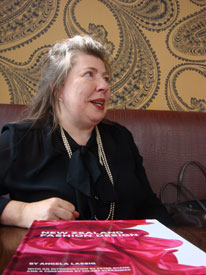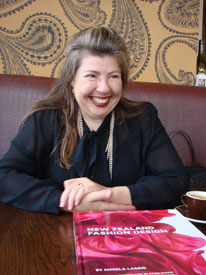|
ANGELA LASSIG IS ONE OF THE REGULARS MOST FASHIONISTAS
know from catwalk shows at New Zealand Fashion Week. We might
get complimented for our note-taking, but Lassig easily outdoes
us: she observes silently and studiously, jotting down as though
she knows more than the journalists in the room combined.
And she probably does.
For many years, Angela Lassig worked at Te Papa as a curator, and to say she has a wealth of knowledge in New Zealand fashion is an understatement. Now she has completed her years at Te Papa with a testament to that knowledge: New Zealand Fashion Design, a weighty tome from Te Papa Press that is unarguably the definitive work on the subject.
There have been attempts at this sphere before: Stacy Gregg’s
Undressed, for instance, in 2003, which cast a journalist’s
eye over the industry. But it was nothing like this. Not only has
Te Papa Press produced the most lavish work possible, Lassig has
covered more designers with an eye on their historical impact. It
is the sort of examination one would expect a museum curator with
 a love of fashion to do: painstakingly researched, written in great
depth, and relevant to future historians. It would be fair to call
New Zealand Fashion Design the seminal work on the subject. a love of fashion to do: painstakingly researched, written in great
depth, and relevant to future historians. It would be fair to call
New Zealand Fashion Design the seminal work on the subject.
Lassig says there must be 10 versions of the book in existence,
referring to the drafts that she discarded before reaching the final
stories that were published. There were, she admits, longer versions
than those that appear, but they could see the light of day in other
forms.
‘It is a history and a snapshot of 2010 … It has the value of
capturing 2010,’ says Lassig.
‘Its approach is that of a fashion historian. I looked
at a tremendous amount of material on 20th-century fashion, and
brought observations that I formed and feel very strongly about.
As you read, you get a feeling of the time and the relationship
[between] designers. I referred to other designers in the essays,
so we get an idea that they did not work in a bubble.’
Her love for the subject began at three to four years
of age, she recalls, and she can still picture a camel-coloured,
thick corduroy vest and trousers, with a skivvy underneath. She
continues to have a love of textiles, garment construction and revivals.
Lassig also spoke of her note-taking at New Zealand
Fashion Week. ‘I am a sponge. I have a tremendous radar for taking
information. [The fashion weeks] were visual research. Having come
from a background of not writing [professionally], I had come to
realize that contemporary fashion was not intimidating.
‘There are people behind the label. They have evolved
in to the role, and it is a very human story,’ she says. ‘I am hoping
that [the book] will make clothing that was seen as very intellectual
as very approachable. I wanted to demystify fashion: fashion is
not there to mystify you.’
With developments in her and her husband’s lives, Lassig
chose to resign from Te Papa at the end of 2009, moving to Auckland
(although, like all long-term Wellingtonians, she misses her former
home). Now an independent fashion historian, curator and writer,
Lassig is spending time embarking on filling more gaps in her writings
on fashion, starting her master’s thesis dealing with the impact
of Christian Dior’s New Look in New Zealand in the 1940s.
She is enjoying the change. Lassig had attempted to
begin a master’s thesis twice before: once when living in Sydney,
and once in Auckland. This time, ‘the stars have aligned.’
The museum world had changed during her time at Te
Papa since 2001. ‘I wasn’t able to spend enough time on the things
I love … Today, you have to multitask. There’s more management involved.’
The shift to more managing, and less curating, meant that Lassig
could not ‘remain hands-on with my writing.
‘I’m happy at the Turnbull [Library] reading room,
reading something that no one’s read for 60 years. You might love
your job but it takes something special to light you up. Writing
this book did.’
The first meetings for the book were conducted in 2005,
when industry experts were asked what they wanted to see from it.
Te Papa Press worked tirelessly on the manuscript with Lassig, sourcing
material for it (including from this title).
While she earns no royalties from the book, Te Papa
was ‘very generous,’ allowing her nine to ten months to write the
book, while her colleagues, of whom she speaks very highly, took
on extra responsibilities. ‘Te Papa’s policy is to provide staff
with opportunities to write within their jobs.’
Leaving was still not an easy decision, despite Lassig’s
belief in fate. She had, after all, curated for 25 years, and leaving
Te Papa meant leaving a quarter-century career. However, writing
it gave her the confidence that she could write well, and she wanted
to be in a position where she could do more of it. ‘I love writing,’
she says.
It does not mean her connection with Te Papa has been
severed. She has been appointed a Te Papa Research Associate and
continues to have a plan for the contemporary collecting of fashion
items, especially of garments selected for New Zealand Fashion
Design, and this may be something she will examine after the
publicity phase of the book.
She has no shortage of ideas. Lately, Lassig has observed
the revival in craft and home dress-making. ‘We are currently experiencing
a growing level of technical proficiency. When this skilled generation
has children, there may be a renaissance in fashion design. Even
though we can afford new clothing, we want to be unique, whether
it’s through a mix of vintage and new or through making. [We ask,]
“How can we stand out now?”’
Lassig may well have a new career as a regular fashion
and trend commentator on the horizon. •
|
 |
‘I am a sponge. I have a tremendous radar for taking
information. [The fashion weeks] were visual research. Having come
from a background of not writing [professionally], I had come to
realize that contemporary fashion was not intimidating’



|

